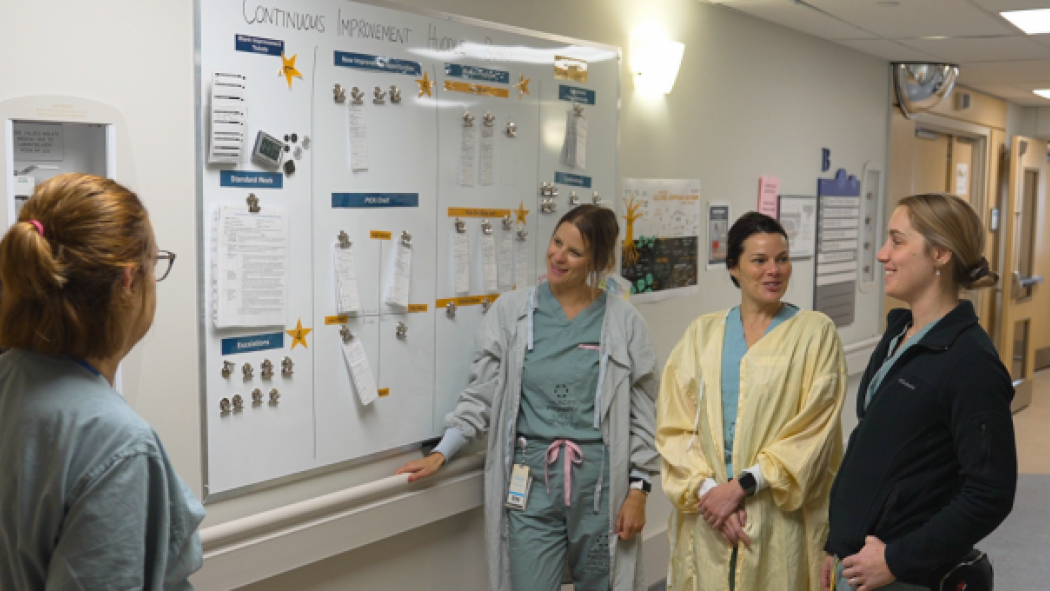
May 30, 2024
Staff in the Birthing Centre at London Health Sciences Centre (LHSC) used the tools of Continuous Improvement of Care (CIC) to improve staffing efficiency and advance care for patients with scheduled Caesarean-sections.
Continuous Improvement of Care is a framework that enables teams at LHSC to make small, incremental process improvements that involve all team members and help improve patient care.
While select teams have embedded the CIC framework into their processes for some time, over the past six months, LHSC has made CIC training for all clinical and non-clinical areas a priority. It is recognized as an important framework that will be essential to our ability to meet our strategic priority of advancing excellence in care, teaching and research.
Over the past several years, early adopters of CIC have embraced these tools to make hundreds of improvements for staff, physicians and patients. One improvement was an update to staffing in the Birthing Centre, which helped create consistency and efficiency in the operating rooms.
The challenge
Historically, staffing in the Birthing Centre operating rooms was coordinated in the moment by a single charge nurse, who was also responsible for the inpatient unit, triage department, and delivery room. Before each scheduled procedure, the charge nurse would determine who would take care of the operating room while also considering what was happening in the delivery room and patients coming from the triage department and the induction list.
“Everything was happening in the moment and relied on the charge nurse to decide what the greatest priority was,” explained Stacy Laureano Steele, Clinical Manager. “That sometimes would mean starting the operating room schedule late or having that schedule get off track because more urgent things were happening in the delivery room.”
An opportunity for improvement was brought forward through a ticket on the team’s huddle board, one of the main tools used in Continuous Improvement of Care. Continuous Improvement Huddles are weekly staff-led meetings of no longer than 15 minutes in which team members can identify challenges or opportunities for improvement in their work. Tickets describing a particular challenge or opportunity can be created by anyone and added to the huddle board; they are then reviewed and prioritized by the team, and when someone has capacity, they can offer to lead the ticket and work with others to find a solution.
The solution
Once the challenge with operating room scheduling was identified on the Birthing Centre’s huddle board, the team began to work towards a solution – the creation of a separate schedule for the operating room which would allow it to run independently.
After testing several different schedules and reporting structures, the team landed on a new and improved structure.
“We added three dedicated nurses to the operating room, and the three of them run the four booked operating room events independently – they run the recovery room, they run the circulating and scrubbing, they get their own breaks, and they take care of each other’s patients,” said Steele.
“The charge nurses don’t have to worry about it anymore,” she explained. “They have a pool of staff to draw from to help manage the inpatient unit, triage department and delivery room, but the operating room is running independently.”
The operating room now runs 95 per cent on time from a nursing standpoint, up from less than 50% before the change, and the new structure has improved patient safety by establishing continuity of care. The team of operating room nurses stays in constant contact with one another and each is aware of the potential complications and risk factors involved in each procedure. On top of the improvements to patient safety, the change has made it easier for staff to understand their role and has helped standardize daily safety checks.
“Continuous Improvement of Care helped our team identify a challenge in a safe environment and putting it on the huddle board initiated discussions with people who hadn’t brought forward ideas before because they hadn’t been asked,” said Steele. “The huddle board is open for anybody that’s part of the team, which I think has really helped us become more collaborative.”
